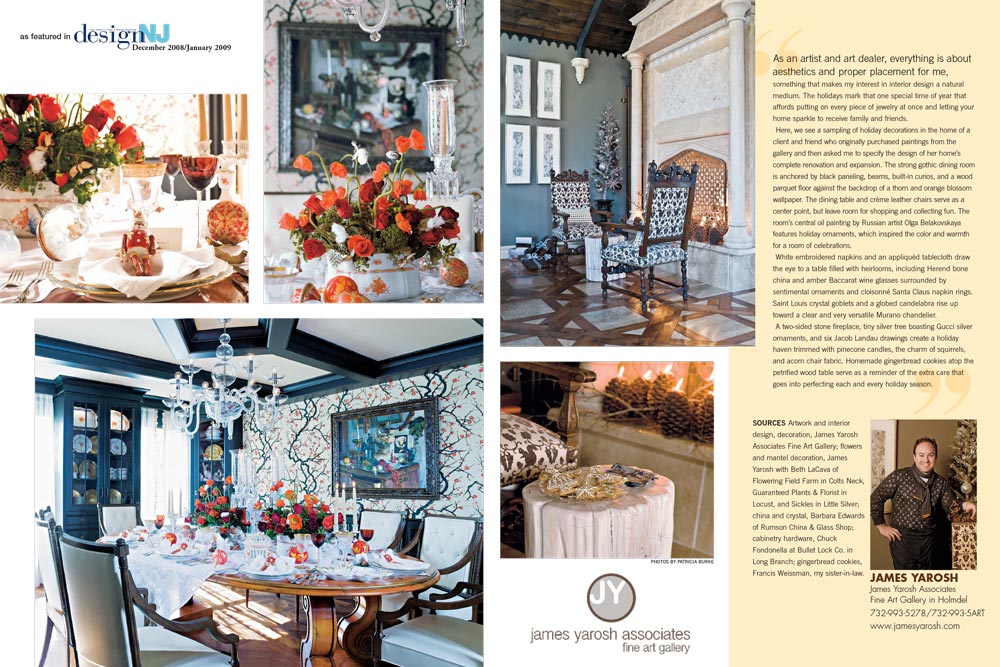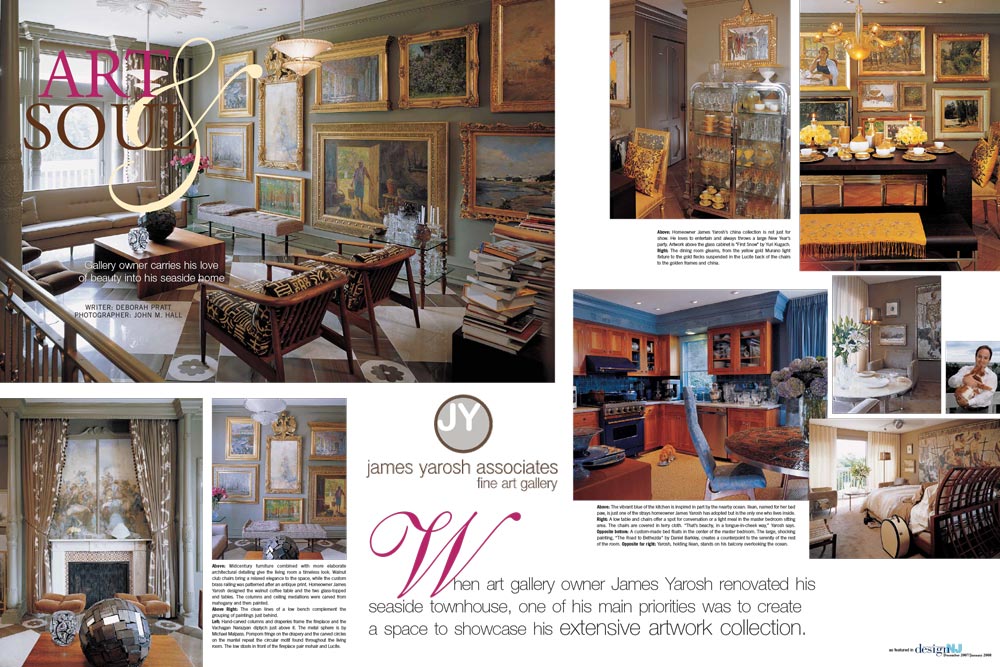ART & SOUL:
Gallery owner carries his love of beauty into his seaside home.
DesignNJ magazine - Dec/Jan 2007-2008
Writer: Deborah Pratt
Photographer: John M. Hall
When art gallery owner James Yarosh renovated his seaside townhouse, one of his main priorities was to create a space to showcase his extensive artwork collection. Many collectors might have taken a purist’s approach, he says, sticking with hardwood floors, white walls, and a spare décor. But that wouldn’t have suited him. “ My home isn’t meant to be a museum, “ he says. “ It’s important for me to feel comfortable in my house as well as have a place to entertain family and friends.” With that in mind, Yarosh opted for “a home that balances a beautiful appreciation for the art of design and artwork with keeping a home that’s warm, inviting, and a place to look forward to spending your days in.”
He struck the balance by giving art a prominent place without shortchanging the rest of the home. Stone wood and Botticino decorative insets add drama to the marble floor. Hand-carved mahogany columns and medallions enhance the walls and ceiling so they aren’t overwhelmed by the artwork. And the house is filled with beautiful things Yarosh loves, from sleek midcentury furniture to elegant Lailque chandeliers to his china collection. “It’s as much about me as anything can be, “he says. “My home is all about what makes me happy personally.”
TIME FOR REDESIGN
The process started about three years ago with the decision to update the home he shares with Barnet Cohn and a cat with a bad paw named Ilean (pun intended.) “The townhouse had a good shell and a good location, with a view of the New York City skyline and of the ocean,” he says. “We basically gutted the main floor, took out some half-walls, and repositioned the fireplace for better symmetry.” With its new position, the fireplace also gained a marble mantel and tile surround. Draperies that soften the look of the fireplace also give importance to the diptych above it.
A circle motif repeats through the living room- the insets on the floor- insets on the floor, the beading on the chandeliers, a design in the bronze railing, a metal sphere on a coffee table, even the pompom fringe on the drapery- and works to unify the room and the areas just beyond it.
To visually connect the living room to the other spaces on the ground floor, the same marble flooring is used throughout, with a large pattern in the living, 12-inch parquet in the dining area, and mosaic tiles in the kitchen. “It looks simple to the eye because it’s all one color,” Yarosh says, “but when you look closer, you notice the distinctions.”
Furnishings are mainly French Moderne and Italian, with low, clean lines. Yarosh designed a couple of the pieces himself: a walnut coffee table and a dowel-and-glass end table. Subtle colors dominate the décor, with vibrant the blue of the kitchen as an exception. “I didn’t do anything cliché ‘beachy’ in the house,” he says, but the colors were inspired by the shore, from the neutral sand tones to the blue of the ocean.
SELF-EXPRESSION
Yarosh sees his art collection as a diary of his life. “The paintings I’ve collected connect with specific times in my life and make them priceless regardless of their market value.” He began as a painter himself and then worked in art galleries before opening his own, James Yarosh Associates Fine Art Gallery in Holmdel, about 14 years ago. “I buy 95 percent with my heart and 5 percent with my head.” He gives that same advice to the designers and homeowners who work with him.
His collection spans time periods and styles, with a recent emphasis on works representing Russian Realism. Subjects range from serene landscapes to the disturbingly haunting “Road to Bethesda” by Daniel Barkely that dominates one wall in his bedroom. Some visitors have questioned the positioning of that particular painting, saying they couldn’t sleep with such a frightening image nearby. “Art doesn’t scare me. Prejudice and hatred scare me. I admire artists tackling strong subject matter,” he says, mentioning Barkley and Jacob Landau.
With such an extensive collection, displaying each piece to its best advantage is an art in itself. Yarosh advises grouping a collection by theme, color, or size. In the dining area, for example, an abundance of gold in the gleaming flecks in Lucite chairs the yellow glass Murano chandelier, and the accents of his china suggested yellow gold frames for the paintings. In a stairwell, he grouped a collection of white works by Vachagan Narazyan, placed to guide the eye in a circle.
The attention to detail is important to Yarosh. “Life is art,” he says. “Everything is about aesthetics for me- clothes, shoes, flowers, music, setting a table, or cooking a meal. Why shouldn’t we want to create a beautiful life for ourselves and those we care for?”


